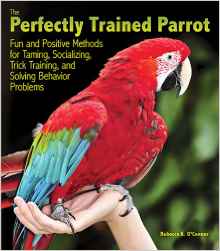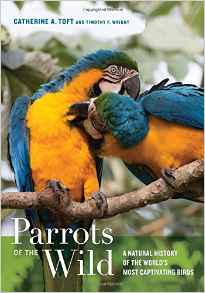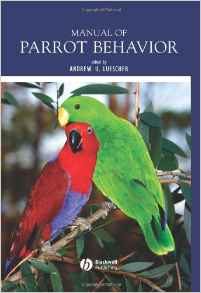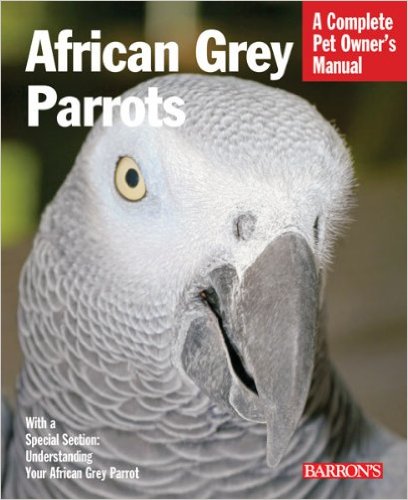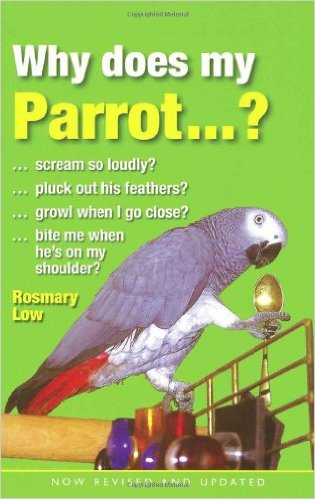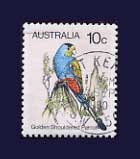The Parrot Family
If you want to buy a book, clicking on the book cover will take you directly to that book on the Amazon.co.uk web site.
See also:

The Perfectly Trained Parrot
Rebecca O’Connor’s book explains how reward-based training works, and how it can be applied to parrots. This is a very useful book for people wanting to train their parrots to accept handling and health checks, as well as teach their parrot to talk. Rebecca O’Conor trains parrots for a living, so is able to give clear advice on teaching parrots to perform all kinds of feats, including fetching, and ‘playing dead’.
There’s no doubt that the methods in this book can help parrots and their owners to get on better. However, there are some limitations, which the book glosses over. The first relates to the needs of parrots, as social animals who are happier living with their own kind, and for foraging, and exploring the world with their beaks and tongues. The second relates to the abnormal behaviour of parrots raised away from their own kind, or which have spent long periods in isolation. Parrots are by nature social birds, so they do best living with other parrots. If they’re hormonal and screeching for a mate, tidbits may not be welcome. If they’re prevented from flying and foraging at dawn and dusk, when wild parrots are most active, they tend to get ‘antsy’ and frustrated.
Parrots raised by humans and kept alone can become very dependent on their human keepers for company. In some ways this book is helpful, in that it encourages owners to interact more with their birds. However, apart from a few species, such as cockatiels and budgies, which have been kept as pets over many generations, pet parrots aren’t really domesticated, they haven’t adapted to living with humans, but are wild creatures living in captivity. Their owners have an obligation to ensure that they’re able to express their natural behaviour as much as possible. Parrots treated as though they were naughty children, rather than intelligent creatures with species-specific needs, may become very frustrated. So, The Perfectly Trained Parrot is only likely to be useful in the hands of someone who is aware of parrots’ natural behaviour, and who plans training activities with that behaviour in mind.

Parrots of the Wild: A Natural History of the World's Most Captivating Birds
Parrots of the Wild is popular science at its best, bringing together a broad range of research on parrots, looking at their evolution, perception, cognition, conservation, as well as wild parrot behaviour. The authors blend this with insights from own work on parrots. It’s a book that can be read for sheer enjoyment because it’s full of interesting facts, yet Parrots of the Wild also pulls together a lot of research in a way that makes it accessible for non-specialists.
This book is one of the best resources on natural parrot behaviour for people who own parrots, and who want to understand them better. The account of how parrots forage, and what they eat, can help owners to recreate opportunities for natural foraging behavious for their pets. Likewise, the accounts of courtship and social behaviour goes a long way to explaining how parrots relate to humans when they don’t have a parrot to relate to. This account can also help people wanting their parrots to breed, as can the information on nesting.
The account of conservation efforts reflects both how parrots’ traditional habitats are changing, and the impact of the trade in parrots for pets. Perhaps the most interesting stories are about wild budgies. We’ve been used to thinking of them as traditional pets, yet they have fascinating social lives in the wild.
All in all, Parrots of the Wild is well worth reading if you’re a parrot owner, an avian vet, or just generally interested in recent research on birds in the wild.

Manual of Parrot Behaviour
Andrew Luescher has edited a selection of articles looking at parrot behaviour from different specialists, giving the reader a range of perspectives on the relationship between parrots and humans. Contributors include lab researchers, vets, and behaviourists. Manual of Parrot Behaviour is not a thorough investigation into the behaviour of wild parrots of different species, though there is a lot of information in natural parrot behaviour in the book. Its strength is as an exploration of how parrots behave when they come into contact with humans in different roles, and how humans in different roles perceive parrots. There are also chapters geared to helping owners to prevent their parrots from developing unwanted habits (like biting and continual screeching!) or cope with birds that have distressing habits. However, again, this book isn’t primarily geared to parrot owners.
Who is likely to find Manual of Parrot Behaviour an interesting read? Probably anyone interested in the behaviour of animals kept by humans, and how humans treat and perceive animals, including vets, and students of animal behaviour and anthrozoology.
A key issue for people concerned with parrots in captivity is that they aren’t truly domesticated, or geared for living with humans, in the way that cats, dogs, and even ferrets are. Domestication is a long-term process whereby animals undergo changes over generations, until their behaviour is altered enough for them to be a comfortable ‘fit’ with that of humans. Some parrots in captivity are wild-caught, and obviously, wild animals don’t take kindly to being deprived of their companions and their freedom. However, even parrots born in captivity and tamed by humans still retain the characteristics of wild parrots. This means both that parrots often upset their owners by behaving like parrots, and that parrots can be driven insane by humans who fail to recognize their need to express their natural behaviour.
There’s now general recognition that pets should be able to behave naturally, within reason, but this message hasn’t been taken on board by all the contributors to this book. The issues here are similar to those raised by training dolphins to perform tricks to amuse humans. However ‘kind’ the training methods used, if the training is simply to get the parrot to amuse humans, and doesn’t take into account a parrot’s need to express its natural behaviour, then it can’t really be called ‘kind’. This is a particular problem with large parrots, especially those kept isolated from their own kind.
When captive parrots can’t express their natural behaviour, they tend to develop abnormal behaviours, not seen among wild parrots. This book details a number of distressing abnormal habits, including feather-plucking and mindless, repetitive movements. The ‘solutions’ offered by some contributors, such as medication, seem to miss the point, that parrots aren’t designed to be companion animals, and if humans take them on, whether as pet owners, or scientific researchers, they have a responsibility to ensure that parrots can behave like parrots as far as possible.
So, while Manual of Parrot Behaviour is a fascinating book, it won’t tell you all you need to know about parrot behaviour. You’ll need to supplement it with more in-depth accounts of the behaviour of wild parrots of different species. This in turn leads to questions about how we humans relate to pets, and how human behaviour can be a little weird!

Alex & Me
This is a very personal account of the relationship between Irene Pepperberg and Alex, a parrot who taught humans to value non-human intelligence. Alex's skills in learning and using another species' language shows that birds have some quite remarkable thinking skills.
Pepperberg also writes about her own life, and the background to the research she carried out, and she introduces other parrots, such as Griffin, giving us a clear idea of the individual character of each bird.
People who want to read in depth about the work that Pepperberg carried out with Alex will be happier with 'The Alex Studies: Cognitive and Communicative Abilities of Grey Parrots', which is, as the title implies, a serious academic work. However, if what you want is a beautifully written, relaxing read, that gives insights into the talents of parrots, and what it's like to live with them, then you'll enjoy 'Alex and Me'. It's well worth reading both books, because 'Alex and Me' makes the drier academic text, 'The Alex Studies' more understandable as an account of a relationship, as well as an important contribution to our understanding of the cognitive abilities of parrots.

The Alex Studies: Cognitive and Communicative Abilities of Grey Parrots
This is the academic version of the story of Irene Pepperberg and Alex the Parrot, who became famous for learning to use human language. It's a fascinating book for anyone interested in language. For example, one way that Irene Pepperberg taught Alex was to teach her assistant in front of him - and as an English teacher, I have found that small children learn well if I have a few sessions 'teaching' their mothers alongside the kids.
Parrots, as Pepperberg has shown, don't just mimic words, they can understand them. It's true that parrots aren't as creative as small humans in producing sentences, but small humans are primed to use human language, whereas parrots are learning the language of another species!
This is an academic book, so it's more enjoyable for people who like serious academic works, and aren't put off by the extensive notes that support what Pepperberg discusses. It also helps you make sense of this book if you have a background in psychology, linguistics, or biology. If you want an easier read, try 'Alex and Me', the more informal account of her relationship with Alex, described above.

African Grey Parrots (Complete Pet Owner's Manual)
For a short, inexpensive book, this is pretty comprehensive, dealing not only with parrot care, also with understanding parrot behaviour, and how you can train your parrot. It's certainly a very good introductory guide for novices, because it covers the main issues well, and is easy to read. Obviously African Greys are very special birds, and it's worth learning more about them than a short book can tell you, whether you've just brought one home, or whether you're considering taking one on. However, as a starter book, this is the pick of the bunch.

Why Does My Parrot?
Rosemary Low has a wealth of experience with parrots, both with her own pets, and as a curator for public parrot collections. Here, she has written a clear guide to parrot behaviour and psychology, which helps explain why some parrots develop behavioural problems, and how you can build up a good relationship with your parrot. The emphasis is on preventing problems from arising, though she also helps you tackle annoying habits that your parrot may have developed.
Parrots can get bored easily, and the type of environment you give your parrot, and how you interact with him or her both affect how your parrot behaves. Much of the book uses a question and answer format to deal with typical problems encountered by parrot owners, and their solutions. There's also background information on how parrots behave in the wild, which helps a lot with understanding what makes them tick. The best time to read this book is before you decide whether or not to take on a parrot. 'Why Does My Parrot ...? gives a clear idea of the commitment involved, and helps you to understand your parrot's needs, an understanding which forms the basis for a good relationship.

